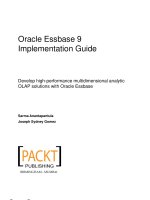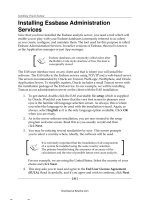Oracle Essbase 9 Implementation Guide- P14 potx
Bạn đang xem bản rút gọn của tài liệu. Xem và tải ngay bản đầy đủ của tài liệu tại đây (712.68 KB, 5 trang )
Essbase Data and Design Considerations
[ 50 ]
Report scripts
Essbase report scripts contain Essbase proprietary and cryptic instructions and
commands. These are typically used in some sort of automated process to generate
actual output reports which are extracted from the cube. Alternately, a report script
can be used to extract data into a at le, to export to a downstream system. These
report scripts can be run manually from the EAS, or from an Essbase command
script (MaxL script in later versions), or even from an API call inside a VB or COM+
application. Essbase report scripts are saved with the
.rep le extension and they
too are ASCII text les. Cursory knowledge is needed for creating or editing Essbase
report scripts as they are actually coded in a symbolic Essbase pseudo-language.
Essbase report scripts are discussed in detail in Chapter 6.
Database load rules les
Raw data from an ASCII text le, Microsoft Excel, or from an RDBMS database
will be loaded into your Essbase cube using Essbase rules le objects.
Essbase rules les can be used in two ways:
• To dynamically build dimensions in the outline and add members
(so you won't need to do it manually).
• To load data where you can dene how the data is loaded, determine what
data to skip or load, perform concatenations of separate columns into one,
and even add business rules.
As with the Essbase report script objects, the rules le can be invoked from the EAS
from an Essbase command script (MaxL script in later versions), or even from an API
call inside a VB or COM+ application. The rules le objects are saved with the .rul
extension and must be created, viewed, and edited through EAS. In Chapter 3, we will
modify the Esscar database outline using the dimension build rules le functionality.
In Chapter 4, we will discuss the data load rule le further.
Allowing duplicate member names
In Essbase 7.x and earlier versions, each outline member had a unique name and
duplicate member names were not allowed. But in System 9, duplicate member
names are allowed. If you want to have duplicate member names in your system,
please make sure you check the ALLOW DUPLICATE MEMBER NAMES while
creating the Essbase database.
This material is copyright and is licensed for the sole use by Paul Corcorran on 5th July 2009
8601 ave. p #1, , lubbock, , 79423
Download at Boykma.Com
Chapter 2
[ 51 ]
Many people scratch their heads and wonder why you would want to allow
duplicate member names in your database outline. Well, one example would be
the city of New York and the state of New York. You may want to have New York
in your outline as one state of the United States and then you may want to have
New York in your outline as a city of New York state.
A standard existing database outline can be converted to allow
duplicate member names, but an outline that allows duplicate
member names cannot be converted back to a standard outline.
Exercise great care when using this option, as it is much like having
data in a relational database table with a duplicate primary key.
Create your rst Essbase database
You have your rst Essbase application created and waiting. You have a good high
level understanding of the types of Essbase databases that can be created. Let's now
create your rst database using EAS.
Select the Esscar application and right-click on it to bring up the application menu.
From the menu, click on Create Database to bring up the following screen:
On the screen above, make sure you have the correct analytic server selected. Select
the correct application (Esscar). Give a name to your database. In this case we will
name the database ESSCAR (it's the same name used for the application).
This material is copyright and is licensed for the sole use by Paul Corcorran on 5th July 2009
8601 ave. p #1, , lubbock, , 79423
Download at Boykma.Com
Essbase Data and Design Considerations
[ 52 ]
Remember, Oracle Essbase only supports
object names upto 8 characters.
Leave the default setting of Normal and do not check Allow Duplicate Member
Names. Click OK and you now have a bouncing Essbase database. Congratulations!
Next, click on (expand) the ESSCAR database name shown under the ESSCAR
application in EAS to reveal the database object selections that were added when
the database was created.
Right-clicking the ESSCAR database reveals several more menu options that
are available to you. Click on the Database Properties selection to bring up
the Database Properties screen shown as follows:
This material is copyright and is licensed for the sole use by Paul Corcorran on 5th July 2009
8601 ave. p #1, , lubbock, , 79423
Download at Boykma.Com
Chapter 2
[ 53 ]
In the Application Properties screen as discussed previously, you see many database
level options or properties that can be set or adjusted to suit your own computing or
performance needs. We will take a moment to briey discuss each available tabbed
option on this screen, and the choices contained therein.
General tab
On this tab, the database name and description are displayed. Only the description
eld is editable and can be changed at will. The database name can be changed
through another function not found on the properties screen (right-click on the
database name in EAS and the Rename Database option will be available).
There is also startup information as shown on the Application Properties screen.
In order to have optimal performance, leave the Allow users to start database
checked and uncheck the Start database when application starts selection.
There is usually no need to have a database start when its parent application starts.
The default calculation settings are best for now. The Aggregate missing values and
Create blocks on equations both have database block size implications and should
be used with extreme care. There will be much more on this topic in Chapter 5 on
database calculation scripts. We leave the Two-Pass calculation option checked,
because it allows you to code a member to use two-pass calculation functionality.
You are not forced to use it just because the option is checked on this screen.
It is highly recommended you set Minimum Access Level to None, as all users must
then be granted specic access to each database. The other choices are Read, Write,
Calculate, and Database Designer.
Data retrieval buffers are settings that help with the performance of the spreadsheet
add-in, and data being extracted with a report script object. More on these will be
discussed in detail later.
This material is copyright and is licensed for the sole use by Paul Corcorran on 5th July 2009
8601 ave. p #1, , lubbock, , 79423
Download at Boykma.Com
Essbase Data and Design Considerations
[ 54 ]
Dimensions tab
In the Dimensions tab, you are presented with information on your database
outline, with regard to the individual dimensions and their designation as either
sparse or dense and the number of members contained. Much more about this
is discussed in Chapter 3.
Statistics tab
The Statistics tab is a Read-only tab, but is very handy as it displays a wealth
of useful information. The following screenshot illustrates this:
This material is copyright and is licensed for the sole use by Paul Corcorran on 5th July 2009
8601 ave. p #1, , lubbock, , 79423
Download at Boykma.Com









